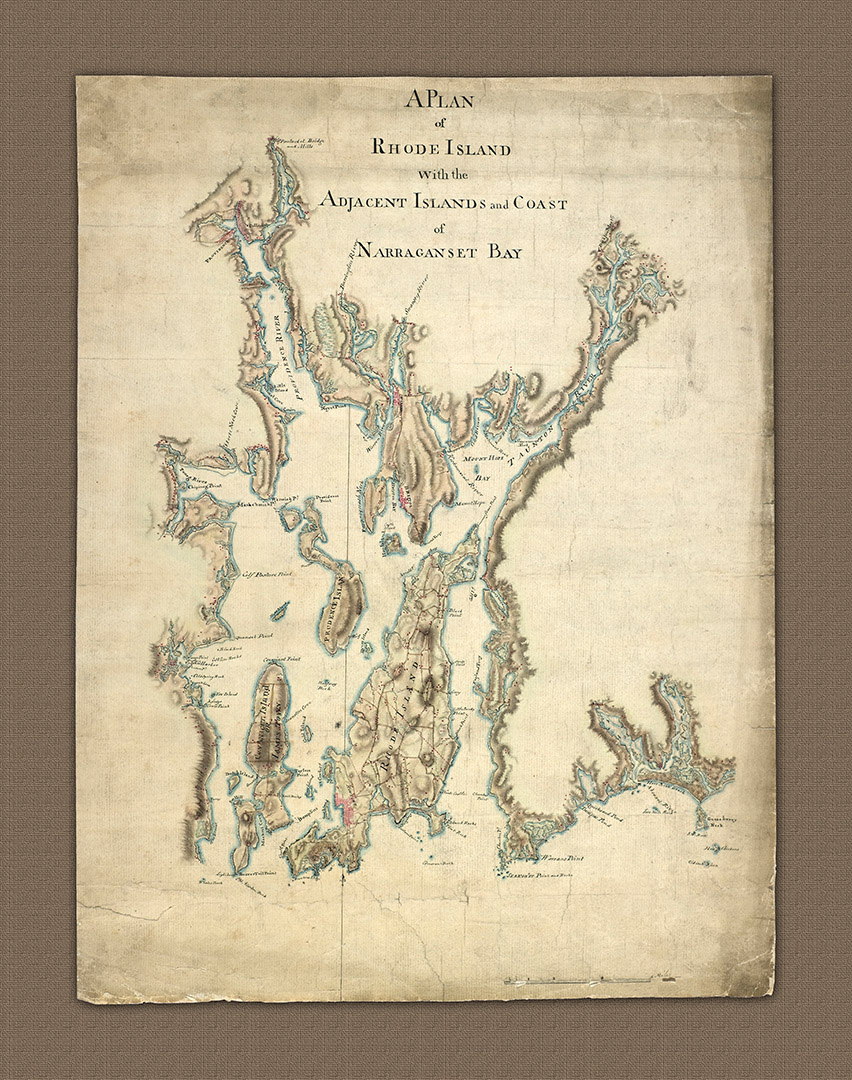
A105 - A plan of Rhode Island and coast of Narragansett Bay
A small hand drawn map of Narrangansett which depicts this important and historic area with subtle colors outlining the coastline, roads and settlements with individual buildings marked and is very much in the 'style' of Charles Blaskowitz although it is credited to Thomas Wheeler. No signature or date is shown.
- c1775
- Thomas Wheeler or Charles Blaskowitz
- h22" x w17"
- P
In 1775 Wheeler and Blaskowitz were ordered to revisit the Narragansett area in order to help complete Samuel Holland's great survey of the Eastern sea board of the United States. Blaskowitz had been responsible for the initial survey of the area completed as early as 1764, for the Board of Admiralty.
Stylistically, this unassuming little map is directly related to the 1776 J.F.W. Des Barres chart of the same area entitled 'A chart of the harbour of Rhode Island and Narragansett Bay'(see Heritage Chart A106). It was also the basis for the the now famous 1777 William Faden map 'A Topographical Chart of the Bay of Narraganset'.
This charming little map is also very similar to a map of Naragansett attibuted to Thomas Wheeler held by The Clements Library, Michigan. (Click here to view)
The survey work from this time is also included in the 1779 chart of New England from Chatham Harbour to Narragansett Bay (A115) by Lt. John Knight and Des Barres. All of the later charts share an almost identical use of place names and detail and were likely based on this earlier survey. No fathoms or soundings are shown, but detail of land features such as fields, hills, roads and settlements are.
By 1770, Narragansett Bay, including Rhode Island, was an increasingly important area, not just for the prosperity it offered, but it was also recognized as being a strategically important deep water harbour between Boston and New York. It had, however, a history of strong opposition to British Parliamentary control and customs laws.
In 1764 Rhode Islanders attacked the British ship HMS St. John and in 1769 they burned the British customs ship, HMS Liberty, on Goat Island in Newport harbour. On June 9, 1772, a British revenue schooner The Gaspé, that had been enforcing unpopular trade regulations and chasing the packet boat Hannah, ran aground in shallow water near what is now known as Gaspé Point by the settlement Warwick. In a notorious act of defiance, American patriots led by Abraham Whipple and John Brown, attacked, boarded, looted, and torched the ship.
In the summer of 1778 the French fleet under Admiral d'Estaing, unable to cross the bar into New York harbour, sailed into Narragansett Bay with infantry reinforcements for the war against the British, only to be repulsed by the weather. By the time he'd regrouped, the British had reinforced the area and the moment was lost.
This beautiful little map was, in all likelyhood, just one of a number of similar copies used by Samuel Holland's team of surveyors in the compelation of a much larger scale map of the earstern seaboard for the Lords of the Board of Trade. One such map would be this one which Heritage Charts are planning to scan and make available soon.
https://www.instagram.com/p/CnOqo_sgXwp/
- A plan of Rhode Island with the adjacent Islands and coast of Narragansett Bay


